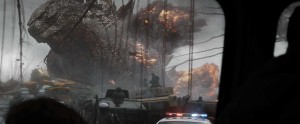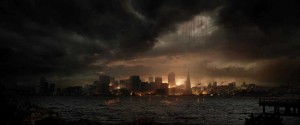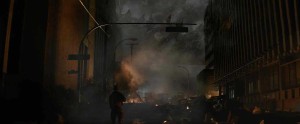
With his background in visual effects, director Gareth Edwards gave MPC an opportunity to push the envelope in designing and executing shots for an epic action adventure while realizing his artistic vision.
 Translating Godzilla from concept artwork to a photo-real living creature took MPC’s artists seven months, working up each part of his body – from the underlying bones, fat and muscle structure to the thickness and texture of his scales. With the close-up nature of the camera work and the sheer scale of the asset, a tremendous amount of detail had to be painted and sculpted to ensure Godzilla looked lifelike on screen.
Translating Godzilla from concept artwork to a photo-real living creature took MPC’s artists seven months, working up each part of his body – from the underlying bones, fat and muscle structure to the thickness and texture of his scales. With the close-up nature of the camera work and the sheer scale of the asset, a tremendous amount of detail had to be painted and sculpted to ensure Godzilla looked lifelike on screen.
With respect for the Toho Co. Ltd.’s original “man in a suit” version, Godzilla was animated as a fluid living and breathing creature with the addition of humanistic elements to capture his attitude and personality. MPC’s artists used a mixture of body language and carefully designed facial expressions, which allowed them to translate emotions and expressions on screen, without breaking the believability of the creature. The company’s animation team used a variety of references, including the movement of bears and reptiles, as a basis for the keyframe animation that gave Godzilla movement.
 For the climax of the film, the team created a digital version of downtown San Francisco, giving the filmmakers complete control over the large-scale virtual cinematography, in order to fully realize Edwards’ striking visual story telling.
For the climax of the film, the team created a digital version of downtown San Francisco, giving the filmmakers complete control over the large-scale virtual cinematography, in order to fully realize Edwards’ striking visual story telling.
The various destruction effects for the complex creature battle sequence were used as an element to remind the viewer of the scale of the monsters in addition to showing a spectacle. A tremendous amount of detail had to be simulated to convey the 350 foot height of Godzilla, involving some extremely high-resolution simulations of buildings collapsing and swirling interactive dust.
MPC’s in-house destruction simulation tool Kali was upgraded and given a number of incremental improvements to make photo-real destruction. The MPC software team added new tools to Kali for tetmesh creation and postprocessing as well as giving it performance improvements, to allow faster simulation and rendering.
MPC’s other work in the movie includes the airport reveal of Godzilla, HALO jump and Golden Gate Bridge attack sequence.





